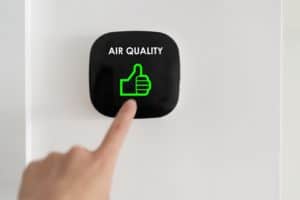Your home is a haven where you may relax and get away from the outside elements. There are instances, however, when your home can make you sick. Poor indoor air quality can cause illnesses even if all other components of your home appear to be in order. Toxic substances and particulates may be present in high concentrations in the air within your home.
Checking for poor indoor air quality should be a top priority for every homeowner. Keep the following factors in mind while evaluating the air quality in your house:

1. Persistent Allergic Reactions
While it’s tempting to blame a recent allergy attack on the changing seasons or weather patterns, the truth is that it’s virtually always the result of a sensitive reaction to chemicals in your home. Pollen, dust, and other pollutants may be more condensed in confined areas than in open spaces, which is why many people develop allergies to a range of chemicals.
Symptoms include sneezing, coughing, eye irritation, migraines, runny nose, and discomfort. Keep a close eye on when these symptoms appear and disappear if you encounter any of them. You’re most certainly dealing with poor indoor air quality if you acquire symptoms immediately after entering your home and disappear shortly after leaving the premises.
Luckily, for one, the help of an air duct cleaning service provider that removes dust, dirt, and other debris can help solve your indoor air problems.
2. Insomnia
The ability to sleep is influenced by both temperature and humidity. In addition, your brain seeks to keep a temperature similar to that of your body, and your body sleeps better with a cooler internal temperature. Internal organs, such as the liver, also require sleep to carry out the tasks set forth by your biological clock.
When the indoor air quality is terrible, sleeping becomes more difficult. Tossing and turning during the night will increase your temperature, therefore, preventing you from cooling down. Due to the high levels of air pollution in the area, your allergies may also become active and make it uncomfortable for you to sleep. It can’t only cause sleep deprivation, but it can also affect your mood during the day.
3. Air Dispersion Inconsistencies
You virtually have a system fault compromising the airflow’s purity if one part of the home is noticeably cooler or warmer than another. It impacts the overall air quality and the temperature at each place. Hot and cold spots might form in your home if the air isn’t circulating correctly. It can happen if your HVAC system is too small for your square footage and can’t handle the air volume in your space.
Clogged ducts or an improperly managed cooling system could also be to blame. If the temperature in your home isn’t consistent throughout, most likely, your filtration isn’t either. Areas that are consistently hot or cold may have pockets of irritants and pollutants.
It’ll help to keep an eye on the humidity levels in different areas. Mugginess or dryness at other times of the year could suggest an issue with your indoor air quality. Depending on the situation, a humidifier or dehumidifier can help you restore the humidity level in your surroundings to a comfortable level for everyone.
4. Flu Or Cold Symptoms
It’s easy to misdiagnose a few indications as a cold or the flu because sore throats, nasal congestion, sneezing, coughing, and dizziness are all frequent signs of poor indoor air quality as well. These symptoms can also be mistaken as allergies due to frequent sneezing and coughing.
Poor air quality is likely at fault if you have a prolonged bad cold that worsens when you’re at home. If your complaints are caused by poor air quality, getting out of the house or taking a walk in the fresh air should help you feel better. If you have any troublesome symptom, talk to your doctor.
5. Nausea And Dizziness
Chemical or gaseous contaminants, such as fumes or carbon monoxide, can impair one’s impaired cognitive performance. Drowsiness, fatigue, or dizziness are some of the first signs of exposure to these pollutants. If any of these symptoms appear suddenly or with exceptional vigor, leave your home until a professional has checked the situation for a gas leak or other potential danger.
6. Mold
Mold growth in your home is a sure sign that your indoor air quality needs to be addressed. Mold flourishes under the right conditions, even though mold spores are easily distributed. In homes with warm, wet air pockets, mold infestations are widespread. Respiratory issues, allergic reactions, inflammation, and psychological anguish have all been linked to mold exposure.
Takeaway
The signs of poor indoor air quality can be straightforward at times, but they can often be subtle. Fortunately, knowledge is power, and you can stay ahead of poor indoor air quality by knowing the list of tell-tale signs above.

Recent Comments